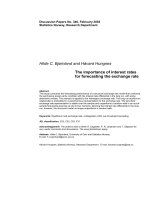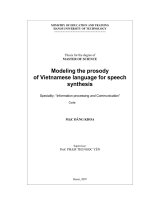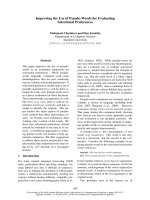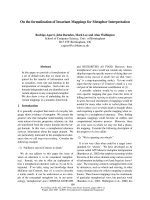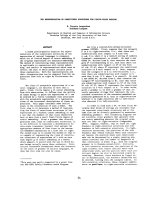The engineering of construction specifications for externally bonded FRP composites
Bạn đang xem bản rút gọn của tài liệu. Xem và tải ngay bản đầy đủ của tài liệu tại đây (6.26 MB, 187 trang )
INFORMATION TO USERS
This manuscript has been reproduced from the microfilm master. UMI films
the text directly from the original or copy submitted. Thus, some thesis and
dissertation copies are in typewriter face, while others may be from any type of
computer printer.
The quality of this reproduction is dependent upon the quality of the
copy submitted. Broken or indistinct print, colored or poor quality illustrations
and photographs, print bleedthrough, substandard margins, and improper
alignment can adversely affect reproduction.
In the unlikely event that the author did not send UMI a complete manuscript
and there are missing pages, these will be noted.
Also, if unauthorized
copyright material had to be removed, a note will indicate the deletion.
Oversize materials (e.g., maps, drawings, charts) are reproduced by
sectioning the original, beginning at the upper left-hand comer and continuing
from left to right in equal sections with small overlaps.
Photographs included in the original manuscript have been reproduced
xerographicaily in this copy.
Higher quality 6” x 9* black and white
photographic prints are available for any photographs or illustrations appearing
in this copy for an additional charge. Contact UMI directly to order.
ProQuest Information and Learning
300 North Zeeb Road. Ann Arbor, Ml 48106-1346 USA
800-521-0600
Reproduced with permission of the copyright owner. Further reproduction prohibited without permission.
Reproduced with permission of the copyright owner. Further reproduction prohibited without permission.
THE ENGINEERING OF CONSTRUCTION SPECIFICATIONS
FOR EXTERNALLY BONDED FRP COMPOSITES
by
XINBAO YANG
A DISSERTATION
Presented to the Faculty of the Graduate School of the
UNIVERSITY OF MISSOURI-ROLLA
In Partial Fulfillment of the Requirements for the Degree
DOCTOR OF PHILOSOPHY
in
CIVIL ENGINEERING
2001
Antonio Nanni, Co-Advisor
T8010
184 pages
Genda Chen, Co-Advisor
Franklin Y. Cheng
Lokeswarappa R. Dharani
Reproduced with permission of the copyright owner. Further reproduction prohibited without permission.
UMI Number 3034873
Copyright 2001 by
Yang, Xinbao
All rights reserved.
UMI
UMI Microform 3034873
Copyright 2002 by ProQuest Information and Learning Company.
All rights reserved. This microform edition is protected against
unauthorized copying under Title 17, United States Code.
ProQuest Information and Learning Company
300 North Zeeb Road
P.O. Box 1346
Ann Arbor, Ml 48106-1346
Reproduced with permission of the copyright owner. Further reproduction prohibited without permission.
COPYRIGHT 2001
XINBAO YANG
ALL RIGHTS RESERVED
Reproduced with permission of the copyright owner. Further reproduction prohibited without permission.
PUBLICATION DISSERTATION OPTION
This dissertation has been prepared in the form of a collection of six technical
papers submitted for publication. The papers are arranged in the order of three research
projects dealing with the application and inspection process of composite materials used
for strengthening and repairing concrete structures. The first paper, consisting of pages 21
through 39, has been accepted for publication in the ASCE Journal of Materials in Civil
Engineering. The second paper, consisting of pages 40 through 47, has been published in
the proceedings of the Fifth International Conference on Fibre-Reinforced Plastics for
Reinforced Concrete Structures (FRPRCS 5), Cambridge, United Kingdom, July 2001.
The third paper, consisting of pages 48 through 59, has been published in the proceedings
of 9th International Conference on Structural Faults & Repair-2001, July 2001, London.
United Kingdom. The fourth paper, consisting of pages 60 through 67, has also been
published in the proceedings of the Fifth International Conference on Fibre-Reinforced
Plastics for Reinforced Concrete Structures (FRPRCS 5), Cambridge, United Kingdom,
July 2001. The fifth paper, consisting of pages 68 through 76, has been accepted for
publication in the proceedings of 16th Annual Technical Conference on Composite
Materials, American Society for Composites, September 2001, Blacksburg, Virginia.
United States. The sixth paper, consisting of pages 77 through 99, has been submitted for
publication in the ACI Materials Journal.
Reproduced with permission of the copyright owner. Further reproduction prohibited without permission.
ABSTRACT
This dissertation, consisting of six technical papers, presents the results of
research on the theme of developing engineering and the construction specifications
for externally bonded FRP composites. For particular, the work focuses on three
critical aspects of the performance of FRP systems: fiber misalignment, comer radius,
and lap splice length. Based on both experimental and theoretical investigations, the
main contribution of this work is the development of recommendations on fiber
misalignment limit, minimum comer radius, lap splice length to be used as guidance
in the construction practice of FRP strengthening of concrete structures.
The first three papers focus on the strength and stiffness degradation of CFRP
laminates from fiber misalignment. It was concluded that misalignment affects
strength more than stiffness.
In practice, when all fibers in a laminate can be
regarded as through fibers, it is recommended to use a reduction factor for strength
and no reduction factor for stiffness to account for fiber misalignment. Findings from
concrete beams strengthened with misaligned CFRP laminates verified these
recommendations.
The fourth and fifth papers investigate the effect of comer radius on the
mechanical properties of CFRP laminates wrapped around a rectangular cross section.
A unique reusable test device was fabricated to determine fiber stress and radial stress
of CFRP laminates with different comer radii. Comparison performed with finite
element analyses shows that the test method and the reusable device were viable and
the stress concentration needs to be considered in FRP laminate wrapped comers. A
minimum of 1.0 in. comer radius was recommended for practice.
The sixth paper summarizes the research on the lap splice length of FRP
laminates under static and repeated loads. Although a lap splice length of 1.5 in. is
sufficient for CFRP laminates to develop the ultimate static tensile strength, a
minimum of 4.0 in. is recommended in order to account for repeated loads.
Reproduced with permission of the copyright owner. Further reproduction prohibited without permission.
ACKNOWLEDGMENTS
The author would like to express his sincere appreciation to his two co-advisors,
Drs. Antonio Nanni and Genda Chen for their continuous guidance, patience, advice and
support in his research.
The author’s appreciation is also extended to the other members of his advisory
committee: Drs. Abdeldjelil Belarbi, Franklin Y. Cheng, and Lokeswarappa R. Dharani
for their time, advice and help.
Special thanks are given to his colleagues and friends: Jeff Bradshow, Jason Cox,
Yumin Yang, Chung Leung Sun, Ji Shen, and Danielle Stone, for their cooperation and
generous help.
The financial support from the Federal Highway Administration (FHWA) and the
University Transportation Center based at UMR are gratefully acknowledged.
Finally, the author wishes to express his deepest appreciation to his parents, and
especially to his wife, Yaping Zhao, for their consistent encouragement, patience and
understanding.
Reproduced with permission of the copyright owner. Further reproduction prohibited without permission.
TABLE OF CONTENTS
Page
PUBLICATION DISSERTATION OPTION...................................................................iii
ABSTRACT....................................................................................................................... iv
ACKNOWLEDGMENTS................................................................................................. v
LIST OF ILLUSTRATIONS..............................................................................................x
LIST OF TABLES.............................................................................................................. xvii
INTRODUCTION............................................................................................................. I
1. Background of Fiber Reinforced Polymer (FRP) Materials.....................................I
2. Strengthening of Infrastructures with FRP Composite Materials............................ 6
3. Research Background and Project Description.........................................................10
4. Thesis Organization................................................................................................... 14
4.1 Fiber Misalignment......................................................................................14
4.2 Comer Radius.............................................................................................. 15
4.3 Lap Splice Length........................................................................................15
4.4 Concluding Remarks................................................................................... 16
5. References.................................................................................................................. 18
PAPER
Paper 1: Strength and Modulus Degradation of CFRP Laminates from Fiber
Misalignment........................................................................................................21
ABSTRACT................................................................................................................. 21
INTRODUCTION....................................................................................................... 21
TEST SPECIMENS...................................................................................................... 22
Material Properties.............................................................................................22
Specimen Characteristics...................................................................................22
Specimen Aspect Ratio......................................................................................23
Specimen Dimensions and End Anchors.......................................................... 23
Instrumentation and Test Protocol.................................................................... 23
TEST RESULTS...........................................................................................................24
Series 1................................................................................................................24
Reproduced with permission of the copyright owner. Further reproduction prohibited without permission.
Series II................................................................................................................25
RESULTS DISCUSSION...............................................................................................25
CONCLUSIONS.............................................................................................................26
ACKNOWLEDGMENT.................................................................................................26
APPENDIX I:
REFERENCES................................................................................... 26
Paper 2: Concrete Beams Strengthened with Misaligned CFRP Laminates.....................40
ABSTRACT.................................................................................................................... 40
INTRODUCTION.......................................................................................................... 40
EXPERIMENTAL PROGRAM.....................................................................................41
Material Properties..............................................................................................41
Specimens and Test Setup..................................................................................42
TEST RESULTS.............................................................................................................43
Strength and Deformation.................................................................................. 43
Strain Distribution and Failure Modes of CFRP Laminates.............................45
CONCLUSIONS.............................................................................................................47
ACKNOWLEDGMENT.................................................................................................47
REFERENCES................................................................................................................47
Paper 3: EFFECT OF FIBER MISALIGNMENT ON FRP LAMINATES AND
STRENGTHENED CONCRETE BEAMS......................................................... 48
ABSTRACT.................................................................................................................... 48
INTRODUCTION...........................................................................................................48
TEST SPECIMENS........................................................................................................ 49
Material Properties..............................................................................................49
Coupon Specimens............................................................................................. 49
Scaled Concrete Beams...................................................................................... 51
TEST RESULTS............................................................................................................. 52
Coupon Tensile Specimens................................................................................ 52
Scaled Concrete Beams...................................................................................... 56
CONCLUSIONS............................................................................................................. 58
ACKNOWLEDGMENT.................................................................................................59
REFERENCES................................................................................................................59
Paper 4: Effect of Comer Radius on the Performance of Externally Bonded FRP
Reproduced with permission of the copyright owner. Further reproduction prohibited without permission.
Reinforcement.......................................................................................................60
ABSTRACT....................................................................................................................60
INTRODUCTION.......................................................................................................... 60
EXPERIMENTAL PROGRAM.................................................................................... 61
Material Properties............................................................................................. 61
Design of Test Specimen................................................................................... 61
Installation of Laminate..................................................................................... 62
Instrumentation...................................................................................................63
TEST RESULTS............................................................................................................ 64
Strength of CFRP laminates...............................................................................64
Strain Distribution.............................................................................................. 65
Failure Modes.....................................................................................................66
CONCLUSIONS............................................................................................................ 67
ACKNOWLEDGMENT................................................................................................ 67
REFERENCES............................................................................................................... 67
Paper 5: STRESSES IN FRP LAMINATES WRAPPED AROUND CORNERS
68
ABSTRACT....................................................................................................................68
INTRODUCTION.......................................................................................................... 68
TEST PROGRAM.......................................................................................................... 69
Materials............................................................................................................. 69
Test Specimen Design........................................................................................69
Installation of Laminate..................................................................................... 70
Instrumentation................................................................................................... 70
ANALYSIS OF EXPERIMENTAL RESULTS............................................................71
Strength of CFRP Laminates............................................................................. 71
Radial Stress Distribution...................................................................................72
FINITE ELEMENT ANALYSIS...................................................................................73
Analytical Model................................................................................................ 73
Results and Discussions..................................................................................... 74
CONCLUSIONS.............................................................................................................75
ACKNOWLEDGMENT................................................................................................ 76
Reproduced with permission of the copyright owner. Further reproduction prohibited without permission.
REFERENCES............................................................................................................... 76
Paper 6: LAP SPLICE LENGTH AND FATIGUE PERFORMANCE OF FRP
LAMINATES....................................................................................................... 77
ABSTRACT................................................................................................................... 77
RESEARCH SIGNIFICANCE......................................................................................77
INTRODUCTION..........................................................................................................78
TEST PROGRAM........................................................................................................ 79
Materials........................................................................................................... 79
Test Specimens and Setup................................................................................ 79
EXPERIMENTAL RESULTS AND ANALYSIS.......................................................80
Lap Splice Length.............................................................................................80
Fatigue Performance of Lap-spliced CFRP Laminates and Theoretical
Prediction..........................................................................................................82
Residual Strength and Stiffness....................................................................... 83
VALIDATION OF A C I440 GUIDE SPECIFICATION............................................ 84
CONCLUSIONS........................................................................................................... 84
ACKNOWLEDGMENT...............................................................................................85
REFERENCES..............................................................................................................85
CONCLUSIONS...............................................................................................................100
APPENDIX I Proposed Standard Test Method for Determining the Effect of Comer
Radius on Tensile Strength of Fiber Reinforced Polymers................................. 102
APPENDIX 2 Stress Strain Curve of Misaligned CFRP Laminates................................. 112
APPENDIX 3 Stress Strain Curve of FRP Laminates with Different Comer Radius
and Confining Stress between Curvature Changing Points................................. 125
APPENDIX 4 Load Strain Curve of Lap Spliced CFRP Laminates..................................153
APPENDIX 5 Recommendations to the AASHTO LRFD Design Specifications, US
Units, Second Edition, 1998 ...............................................................................161
VITA...................................................................................................................................166
Reproduced with permission of the copyright owner. Further reproduction prohibited without permission.
X
LIST OF ILLUSTRATIONS
Figure
Page
INTRODUCTION
1 Glass, Aramid and Carbon FRP S heet............................................................... 2
2 Carbon and Glass FRP R ods...............................................................................2
3 CFRP Strengthening System............................................................................... 4
4 General Organization of Thesis.......................................................................... 17
Paper I
1 Width of through fibers of misaligned CFRP laminates.................................... 31
2 One-ply CFRP specimens....................................................................................32
3 Specimen in the testing machine......................................................................... 33
4 Stress-strain curve of one-ply specimen............................................................. 34
5 Stress-strain curve of two-ply specim en........................................................... 34
6 Normalized strength of one-ply specimens.........................................................35
7 Normalized modulus of one-ply specimens........................................................35
8 Normalized strength of two-ply specimens.........................................................36
9 Normalized modulus of two-ply specimens....................................................... 36
10 Failure modes of selected specimens for Series 1................................................ 37
11 Size effect on strength of CFRP laminate............................................................38
12 Size effect on tensile modulus of CFRP laminate............................................... 38
13 Normalized gross strength vs. percent of effective width of all specimens
39
14 Normalized gross modulus vs. percent of effective width of all specimens
39
Paper 2
1 Specimen and strengthening................................................................................ 42
2 Strain gage arrangement....................................................................................... 43
3 Load-midspan deflection of all beams................................................................. 43
4 Degradation of ultimate load............................................................................... 44
5 Degradation of midspan deflection..................................................................... 44
Reproduced with permission of the copyright owner. Further reproduction prohibited without permission.
6 Modulus degradation of tensile coupons and beams...........................................45
7 Strain distribution of all beams............................................................................ 45
8 Delamination of CFRP laminates........................................................................ 46
Paper 3
1 CFRP coupon specimens......................................................................................50
2 Specimen in the testing machine..........................................................................50
3 Width of through fibers of misaligned CFRP laminates..................................... 50
4 Design of beams and CFRP system(mm)............................................................ 51
5 Strain gage arrangement(mm).............................................................................. 52
6 Stress-strain curves of one-ply specimens.......................................................... 53
7 Normalized strength of one-ply specimens.........................................................54
8 Normalized modulus of one-ply specimens........................................................ 54
9 Size effect on strength of CFRP laminate............................................................55
10 Size effect on tensile modulus of CFRPlaminate................................................ 56
11 Load-midspan deflection of all beams.................................................................56
12 Change in of ultimate load................................................................................... 57
13 Change in midspan deflection.............................................................................. 57
14 Modulus degradation of CFRP laminate............................................................. 57
15 Strain distribution of all beams............................................................................ 58
16 Delamination of CFRP laminates.........................................................................58
Paper 4
L Test apparatus(Unit: mm).....................................................................................62
2 Strain gage arrangement....................................................................................... 63
3 Test setup.............................................................................................................. 63
4 Ultimate load and stress vs. comer radius........................................................... 64
5 Stress-strain curves of CFRP laminates.............................................................. 65
6 Strain distribution around a comer.......................................................................65
7 Failure modes of CFRP laminates........................................................................66
Paper 5
1 Test apparatus(Unit: mm)..................................................................................... 69
2 Test setup.............................................................................................................. 71
Reproduced with permission of the copyright owner. Further reproduction prohibited without permission.
3
Ultimate stress vs. comer radius......................................................................... 71
4
Normalized ultimate stress of CFRP laminate................................................... 72
5
Pressure film....................................................................................................... 73
6
Radial stress distribution.....................................................................................73
7
(a) A quarter of the test apparatus, (b) Finite elementanalytical model............ 73
8 Ultimate radial stress by FEA and test............................................................... 74
9
Radial stress distribution in comer area for R=25.4 mm................................... 74
10 Stress concentration factor.................................................................................. ^
11 Stress concentration factor distribution..............................................................
Paper 6
1 Couple in Single Layer Specimen...................................................................... 90
2 Symmetrical Configuration of a Specimen (unit:mm)....................................... 91
3 Coupon Specimen and Test Setup...................................................................... 92
4 Failure Load versus Lap Splice Length.............................................................. 93
5 Strain Gage Distribution of 101.6-mm Lap-spliced Specimens........................ 93
6 Load-Strain Curves on CFRP Laminates............................................................94
7 Strain Distribution in Lapped and Non-lapped Areas (101.6-mm lap splice
length)...................................................................................................................95
8 FRP Laminate Fatigue Life................................................................................. 96
9 Load-Strain Curves after Fatigue Loading..........................................................97
10 Strain Change with Fatigue Cycles................................................................... 98
11 Residual Strength of CFRP Laminates............................................................... 99
APPENDIX 1
1 Assembled Test Fixture....................................................................................... 104
2 Upper Part of Test Fixture(mm).......................................................................... 104
3 Lower Part of Test Fixture(mm).......................................................................... 105
4 Interchangeable Comer Inserts(mm)................................................................... 105
5 Tensile Fixture(Two sets needed) (mm)..............................................................106
6 Installation of Specimen and Suggested Strain Gage Arrangement(mm).......... 106
Reproduced with permission of the copyright owner. Further reproduction prohibited without permission.
APPENDIX 2
1
Stress strain curve of one-ply CFRP laminate ( 9 =0°)...................................... 113
2
Stress strain curve of one-ply CFRP laminate ( 9 =5°)...................................... 113
3
Stress strain curve of one-ply CFRP laminate ( 9 = 10°)....................................114
4
Stress strain curve of one-ply CFRP laminate ( 9 =15°)...................................114
5
Stress strain curve of one-ply CFRP laminate ( 9 =20°)...................................115
6
Stress strain curve of one-ply CFRP laminate ( 9 =30°)....................................115
7
Stress strain curve of one-ply CFRP laminate ( 6 =40°).................................... 116
8
Stress strain curve of two-ply CFRP laminate ( 9 =0°~0°)
(based on gross sectional area)............................................................................116
9 Stress strain curve of two-ply CFRP laminate ( 9 =0°~5°)
(based on gross sectional area)............................................................................ 117
10 Stress strain curve of two-ply CFRP laminate ( 9 =0°~ 10°)
(based on gross sectional area)............................................................................ 117
11 Stress strain curve of two-ply CFRP laminate ( 9 =0°~ 15°)
(based on gross sectional area)............................................................................ 118
12 Stress strain curve of two-ply CFRP laminate ( 9 =0°~30°)
(based on gross sectional area)............................................................................ 118
13 Stress strain curve of two-ply CFRP laminate ( 9 =0°~45°)
(based on gross sectional area)............................................................................ 119
14 Stress strain curve of two-ply CFRP laminate ( 9 =0°-60°)
(based on gross sectional area)............................................................................ 119
15 Stress strain curve of two-ply CFRP laminate ( 9 =0°~90°)
(based on gross sectional area)..............................................................................120
16 Stress strain curve of two-ply CFRP laminate ( 9 =0°~0°)
(based on sectional area of through fibers)...........................................................120
17 Stress strain curve of two-ply CFRP laminate ( 9 =0°~5°)
(based on sectional area of through fibers)...........................................................121
18 Stress strain curve of two-ply CFRP laminate ( 9 =0°~ 10°)
(based on sectional area of through fibers)...........................................................121
19 Stress strain curve of two-ply CFRP laminate ( 9 =0°~15°)
(based on sectional area of through fibers)...........................................................122
20 Stress strain curve of two-ply CFRP laminate ( 9 =0°~30°)
(based on sectional area of through fibers)...........................................................122
21 Stress strain curve of two-ply CFRP laminate ( 9 =0°~45°) (based on
sectional area of through fibers)........................................................................... 123
Reproduced with permission of the copyright owner. Further reproduction prohibited without permission.
xiv
22 Stress strain curve of two-ply CFRP laminate ( 6 =0°~60°)
(based on sectional area of through fibers)...........................................................123
23 Stress strain curve of two-ply CFRP laminate ( 6 =0°~90°)
(based on sectional area of through fibers)...........................................................124
APPENDIX 3
1 Stress strain curve of one ply CFRP laminates (R=0.0 mm, Specimen I)
126
2 Stress strain curve of one ply CFRP laminates (R=0.0 mm. Specimen 2)..........126
3 Stress strain curve of one ply CFRP laminates (R=0.0 mm. Specimen 3)..........127
4 Stress strain curve of one ply CFRP laminates (R=6.35 mm, Specimen I)
127
5 Stress strain curve of one ply CFRP laminates (R=6.35 mm, Specimen 2)........128
6 Stress strain curve of one ply CFRP laminates (R=6.35 mm, Specimen 3)........128
7 Stress strain curve of one ply CFRP laminates (R=12.7 mm. Specimen 1)........129
8 Stress strain curve of one ply CFRP laminates (R=12.7 mm, Specimen 2)........129
9 Stress strain curve of one ply CFRP laminates (R=12.7 mm, Specimen 3)........ 130
10 Stress strain curve of one ply CFRP laminates (R=19.0 mm. Specimen 1)........ 130
11 Stress strain curve of one ply CFRP laminates (R=19.0 mm. Specimen 2)........131
12 Stress strain curve of one ply CFRP laminates (R=19.0 mm. Specimen 3)........ 131
13 Stress strain curve of one ply CFRP laminates (R=25.4 mm. Specimen I)
132
14 Stress strain curve of one ply CFRP laminates (R=25.4 mm. Specimen 2)........ 132
15 Stress strain curve of one ply CFRP laminates (R=25.4 mm, Specimen 3)........133
16 Stress strain curve of one ply CFRP laminates (R=38.1 mm. Specimen 1)........ 133
17 Stress strain curve of one ply CFRP laminates (R=38.l nun, Specimen 2)........134
18 Stress strain curve of one ply CFRP laminates (R=38.l mm. Specimen 3)........134
19 Stress strain curve of one ply CFRP laminates (R=50.8 mm, Specimen 1)........135
20 Stress strain curve of one ply CFRP laminates (R=50.8 mm, Specimen 2)........135
21 Stress strain curve of one ply CFRP laminates (R=50.8 mm. Specimen 3)........136
22 Stress strain curve of two ply CFRP laminates (R=0.0 mm, Specimen I)..........136
23 Stress strain curve of two ply CFRP laminates (R=0.0 mm, Specimen 2)..........137
24 Stress strain curve of two ply CFRP laminates (R=6.35 mm, Specimen 1)........137
25 Stress strain curve of two ply CFRP laminates (R=6.35 mm. Specimen 2)........138
26 Stress strain curve of two ply CFRP laminates (R=12.7 mm. Specimen 1)........138
27 Stress strain curve of two ply CFRP laminates (R=12.7 mm. Specimen 2)........139
Reproduced with permission of the copyright owner. Further reproduction prohibited without permission.
XV
28 Stress strain curve of two ply CFRP laminates (R=19.0
mm, Specimen I).....139
29 Stress strain curve of two ply CFRP laminates (R=19.0
mm, Specimen 2).....140
30 Stress strain curve of two ply CFRP laminates (R=25.4
mm, Specimen I).....140
31 Stress strain curve of two ply CFRP laminates (R=25.4
mm, Specimen 2).....141
32 Stress strain curve of two ply CFRP laminates (R=38.l
mm. Specimen I).....141
33 Stress strain curve of two ply CFRP laminates (R=38.1
mm. Specimen 2).....142
34 Stress strain curve of two ply CFRP laminates (R=50.8
mm. Specimen I).....142
35 Stress strain curve of two ply CFRP laminates (R=50.8
mm, Specimen 2).....143
36 Stress strain curve of one ply AFRP laminates (R=6.35....mm, Specimen I).....143
37 Stress strain curve of one ply AFRP laminates (R=6.35
mm. Specimen 2).....144
38 Stress strain curve of one ply AFRP laminates (R=12.7....mm. Specimen I).....144
39 Stress strain curve of one ply AFRP laminates (R=12.7....mm. Specimen 2).....145
40 Stress strain curve of one ply AFRP laminates (R=25.4
mm, Specimen I).....145
41 Stress strain curve of one ply AFRP laminates (R=25.4
mm. Specimen 2).....146
42 Stress strain curve of one ply AFRP laminates (R=38.1
mm. Specimen 1).....146
43 Stress strain curve of one ply AFRP laminates (R=38.l
mm. Specimen 2).....147
44 Stress strain curve of one ply AFRP laminates (R=50.8
mm. Specimen I).....147
45 Confining stress between curvature changing points (R=6.35 mm (0.25 in))... 148
46 Confining stress between curvature changing points (R=12.7 mm (0.5 in)).... 148
47 Confining stress between curvature changing points (R=19.0 mm (0.75 in))... 149
48 Confining stress between curvature changing points (R=25.4 mm (1.0 in)).... 149
49 Confining stress between curvature changing points (R=38.1 mm (1.5 in)).... 150
50 Confining stress between curvature changing points (R=50.8 mm (2.0 in)).... 150
APPENDIX 4
1 Load strain curve of lap spliced CFRP laminates
(Lap splice length d=12.7 mm, specimen I)........................................................ 152
2 Load strain curve of lap spliced CFRP laminates
(Lap splice length d=l2.7 mm, specimen 2).......................................................152
3 Load strain curve of lap spliced CFRP laminates
(Lap splice length d=l2.7 mm, specimen 3).......................................................153
4 Load straincurve of lap spliced CFRP laminates
(Lap splice length d=25.4 mm, specimen 1).......................................................153
Reproduced with permission of the copyright owner. Further reproduction prohibited without permission.
'
xvi
5 Load strain curve of lap spliced CFRP laminates
(Lap splice length d=25A mm, specimen 2)........................................................ 154
6 Load strain curve of lap spliced CFRP laminates
(Lap splice length d=25A mm, specimen 3)........................................................ 154
7 Load strain curve of lap spliced CFRP laminates
(Lap splice length d=38.1 mm, specimen 1)........................................................ 155
8 Load strain curve of lap spliced CFRP laminates
(Lap splice length d=38.1 mm, specimen 2)........................................................ 155
9 Load strain curve of lap spliced CFRP laminates
(Lap splice length d=38.l mm, specimen 3)........................................................ 156
10 Load strain curve of lap spliced CFRP laminates
(Lap splice length d=50.8 mm, specimen I)........................................................ 156
11 Load strain curve of lap spliced CFRP laminates
(Lap splice length d=50.8 mm, specimen 2)........................................................ 157
12 Load strain curve of lap spliced CFRP laminates
(Lap splice length d=50.8 mm, specimen 3)........................................................ 157
13 Load strain curve of lap spliced CFRP laminates
(Lap splice length d=16.2 mm, specimen I)........................................................ 158
14 Load strain curve of lap spliced CFRP laminates
(Lap splice length d=76.2 mm, specimen 2)........................................................ 158
15 Load strain curve of lap spliced CFRP laminates
(Lap splice length d=16.2 mm, specimen 3)........................................................ 159
16 Load strain curve of lap spliced CFRP laminates
(Lap splice length 17 Load strain curve of lap spliced CFRP laminates
(Lap splice length
Reproduced with permission of the copyright owner. Further reproduction prohibited without permission.
LIST OF TABLES
Table
Page
INTRODUCTION
1 Mechanical Properties of Different Types of Fibers (MBrace 1998)................3
2
Typical Density of FRP Materials, lb/ft3(g/cm3) (MBrace 1998)..................... 3
3 Topics Related to Repair/Strengthening with FRP Sheets and Prefabricated
Laminates..............................................................................................................13
4 Topics Related to Repair/Strengthening with Near Surface Mounted FRP
Rods....................................................................................................................... 14
5 Topics Related to Repair/Strengthening with External Post-Tensioned FRP... 14
Paper I
1 Manufacturer provided CFRP properties............................................................ 28
2 Strengths and moduli of one-ply specimens....................................................... 28
3 Strengths and moduli of two-ply specimens.......................................................29
4 Variation of strengths and moduli with aspect ratio
(misalignment angle 0 = 5°, width W = 38.1 mm)..............................................30
5 Variation of strengths and modulus with aspect ratio
(misalignment angle 0 = 10°, width W = 38.1 mm)............................................30
Paper 2
1 Mechanical properties of CF130 tow sheet.........................................................41
2 Mechanical properties of MBrace saturant......................................................... 41
3 Ultimate load and deflection of all beams...........................................................44
Paper 3
1 Manufacturer provided CFRP properties............................................................ 49
2 Strengths and moduli of specimens Series 1....................................................... 53
3 Variation of strengths and moduli with aspect ratio........................................... 55
4 Variation of strengths and modulus with aspect ratio........................................ 55
5 Ultimate load and deflection of all beams...........................................................57
Reproduced with permission of the copyright owner. Further reproduction prohibited without permission.
Paper 4
1 Manufacturer provided CFRPproperties............................................................ 61
2
Average ultimate results..................................................................................... 64
Paper 6
1 Failure Load........................................................................................................ 89
2
Fatigue Test Matrix and Results......................................................................... 89
Reproduced with permission of the copyright owner. Further reproduction prohibited without permission.
INTRODUCTION
1. Background of Fiber Reinforced Polymer (FRP) Materials
Composite materials are made of two or more distinct constituents, which can be
categorized as reinforcement phase(s) and binder phase(s). The most popularly used
advanced composite materials are fibers impregnated in a polymeric resin, also known as
fiber reinforced polymer (FRP) materials. In a composite material, the fibers take the role
of the principal load-bearing constituent and the resin (matrix) has the role of transferring
the load, providing a barrier against adverse environment, and protecting the surface of
fibers from mechanical abrasion.
Composites using fiber-reinforced materials of various types have created a
revolution in high-performance structures in recent years. They offer significant
advantages in strength and stiffness coupled with light-weight relative to conventionally
used metallic materials. Along with this structural performance comes the freedom to
select the orientation of the fibers for optimum performance. In this sense, advanced
composite materials have been described as being revolutionary because the materials
can be designed as well as the structure (Swanson 1997).
FRP materials are anisotropic and are characterized by excellent tensile strength
in the fiber direction. No yielding is exhibited in FRP materials, but instead they are
elastic up to failure. The current commercially available FRP reinforcements are usually
made of continuous fibers of aramid (AFRP), carbon (CFRP), or glass (GFRP). They can
be produced by different manufacturing methods in many shapes and forms; the most
popular ones for concrete reinforcement are rebars, prestressing tendons, precured
laminates/shells and fiber sheets. Commonly used FRP rods have various types of
deformation systems, including externally wound fibers, sand coatings, and separately
formed deformations. These rods are commonly used for internal or near surface
mounted concrete reinforcement. FRP prefabricated laminates and sheets are commonly
used for external reinforcement for strengthening/repairing concrete structures. FRP
plane laminates have been used to replace bonded steel plates (Sharif and Baluch 1996)
and FRP shells have been used as jackets for columns (Xiao and Ma 1997).
Reproduced with permission of the copyright owner. Further reproduction prohibited without permission.
Figures 1 and 2 show some types of FRP composites used in the structural
engineering lab of the University of Missouri-Rolla. Figure I shows unidirectional glass,
aramid, and carbon fiber sheets. Different kinds of FRP rods are shown in Figure 2.
Fig. 1 Glass, Aramid and Carbon FRP Sheet
Fig. 2 Carbon and Glass FRP Rods
To give an idea of the basic mechanical properties of fiber sheets, the strength,
modulus, and strain of glass, carbon, and aramid fibers are listed in Tables 1 and 2.
Compared with conventional materials (e.g. steel), the advantages of fiber composites are
often related to the ratios of stiffness and strength to weight, durability, creep and fatigue
performance. Along with these advantages are the easy handling and installation, lower
transportation cost, lower dead load, and excellent environmental resistance, which make
FRP materials suitable for use with concrete structures and perform better than other
construction materials in terms of weathering behaviors. Usually the tensile strength of
FRP sheets is 10-20% less than that of fibers with equivalent volume. This is because
Reproduced with permission of the copyright owner. Further reproduction prohibited without permission.
3
fibers in a sheet are not uniformly arranged and there is strength redistribution due to the
reorientation of fibers under load (Maruyama 1997).
Table I Mechanical Properties of Different Types of Fibers (MBrace 1998)
Fiber
Ultimate
Strength
ksi (MPa)
Design
Strength
ksi (MPa)
Modulus of
Elasticity
ksi (MPa)
CF 130 High
Strength
620(4275)
550(3790)
33,000(228.000)
Carbon
CF530 High
Modulus
584(4027)
510(3517)
54,000(372,000)
Carbon
EG900
251(1730)
220(1517)
10.500(72,400)
E-Glass
Aramid*
348(2401)
298(2058)
17,400(120,000)
AK-60
* Properties of aramid AK-60 were provided by Chang, K of DuPont.
Design
Strain
in/in
Thickness per
Ply
in (mm)
0.017
0.0065(0.165)
0.009
0.0065(0.165)
0.021
0.0139(0.353)
0.017
0.0286(0.726)
Table 2 Typical Density of FRP Materials, lb/ft3(g/cm3) (MBrace 1998)
GFRP
CFRP
AFRP
Steel
75-130
(1.2-2.1)
90-100
(1.2-1.6)
75-90
(1.2-13)
492.5
(7.9)
Conventionally used polymeric resins with FRP systems include primers, putty
fillers, saturants, and adhesives. The primer is used to penetrate the concrete surface to
provide an improved adhesive bond for the saturanting resin of adhesive. The putty is
used to fill small surface voids in the concrete substrate and to provide a smooth surface
to which the FRP can be bonded. Filled surface voids can also prevent bubbles from
forming during curing of saturant and from creating stress concentration and load failure
of FRP laminates due to realignment in case of bridging voids. The saturant is used to
impregnate the fibers, fix them in place, and provide a shear path to effectively transfer
load between fibers. The saturant also serves as the adhesive for wet lay-up systems
providing a shear path between the previously primed concrete substrate and the FRP
system. For prefabricated FRP laminate systems, adhesives are used to bond them to
concrete substrate, which provides a shear path between the concrete substrate and the
laminates. Adhesives are also used to bond together multiple layers of prefabricated FRP
Reproduced with permission of the copyright owner. Further reproduction prohibited without permission.
4
laminates. Figure 3 indicates a complete CFRP strengthening system bonded to concrete
substrate.
Protective Coaling'
2nd layer of Resli
C aban Fiber _
l i t layer of Reeln
Fig. 3 CFRP Strengthening System
It is of importance that the integrity of the FRP systems be achieved and
maintained which depends on the construction quality to apply the FRP, the strength and
the quality of the concrete. A generally accepted application process is described step by
step as follows (MBrace 1998):
Step 1: preparation of the concrete substrate
Prior to installing the FRP strengthening system, the concrete substrate need to be
prepared to accept the system, the surface of the concrete should be free of loose and
unsound materials. All laitance, dirt, dust, oil, etc. should be removed. Sandblasting,
water jetting, mechanical grinding or other approved methods should be used to open the
pore structure of the concrete and make the surface rough as expected.
Step 2: application of primer
Primer is applied to the properly prepared concrete surface using a short or
medium nap roller with a volume coverage of 200-250 fr/gal.
Step 3: application of putty
Putty is applied to the primed surface using a trowel. The putty should be used to
fill any surface defects; complete coverage is not necessary. The putty may be applied to
a freshly primed surface without waiting for the primer to cure. The volume coverage for
putty is 6-12 fr/gal.
Reproduced with permission of the copyright owner. Further reproduction prohibited without permission.




